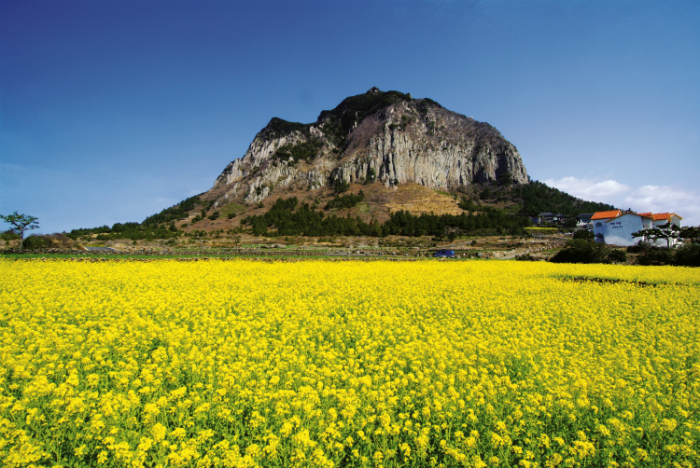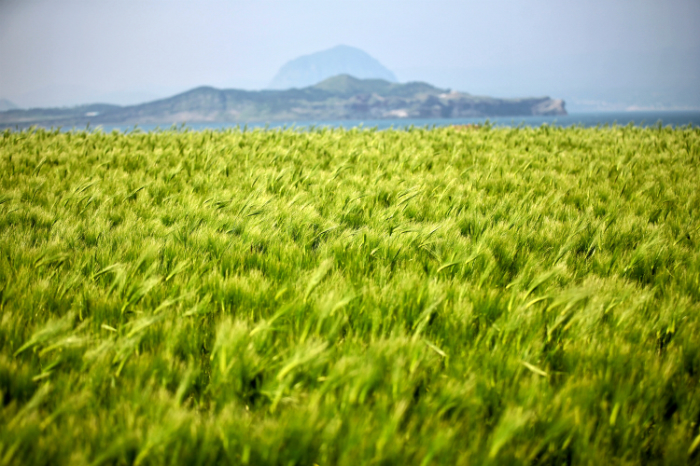Spring fragrances fill Jeju fields

Thousands of yellow canola blossoms carpet the foothills of Jeju’s Sanbangsan Mountain every spring. The Jeju Tourism Organization has designated this area and the neighboring Yongmeori Beach as one of island’s must-see sites during the month of April.
By Kim Young-ah and Lee Hana
Photos = Jeju Tourism Organization
With the warm breezes of spring already in the air, there’s no better time to hit the road.
The Ministry of Culture, Sports and Tourism has designated the period from April 29 to May 14 as the official 2017 Spring Travel Week, giving backpackers the option to choose from a variety of travel packages, with discounts offered for festivals across the country.
As always, Jeju Island was first to welcome the glory of spring this year. To help travelers plan their trip to the southern isles, the Jeju Tourism Organization (JTO) announced its top 10 list of places to visit in the springtime, organized under seven separate themes.
One of the first places to visit is the campus of Jeju University. At the start of April, the road leading to the campus gates transforms into a fragrant white tunnel formed by row upon row of king cherries, a native blossoming cherry tree indigenous to Jeju.
In the second week of April, visitors can also look forward to a shower of cherry blossom petals along the mid-altitude slopes of Hallasan Mountain, at sites like Gwaneumsa Temple (관음사) and along Sanggan-ro Road (산간도로) leading to the mountain.
Another flower that symbolizes Jeju’s spring is the canola. In the foothills of Sanbangsan Mountain (산방산), along the hiking trails by Yongmeori Beach (용머리해안), the canola flowers form an endless carpet of bright yellow. Visitors will feel like they are standing inside a landscape painting. Yongmeori Beach is located in Andeok-myeon County in Seogwipo-si City. The 13.7 kilometer trail starts at Hyeongje Haean-ro Street (형제해안로), winds its way to the Daejeonghyanggyo Confucian School (대정향교), and then weaves back again to the Yongmeori Beach along Sanbangsan Mountain.

Fields of barley ripple in the breeze on Gapa-do Island, located some 2.2 kilometers off the southernmost tip of Jeju.
Jeju’s green tea plantations and barley fields also come to life in the spring. Against the backdrop of the emerald ocean, the green shoots of the tea leaves and the barley grain create spectacular sceneries, filled to the brim with spring’s vibrant energy.
Some of the region’s major green tea plantations include the Seogwi Dawon (서귀다원) in Seogwipo-si City, the Orteas Dawon (올티스다원) in Jocheon-eup Village, and the Onulun Plantation (오늘은 녹차한잔) in Pyoseon-myeon County. At these locations, it’s possible to taste a variety of beverages and desserts made with green tea leaves harvested fresh from the farms.
One of the most beautiful barley fields to check out is on Gapa-do Island, which can be reached in 20 minutes by ferry from Moseul-po Port (모슬포항구), off the southernmost tip of Jeju. The annual Gapa Green Barley Festival runs from April 9 to May 8.
To find out more about other destinations featured on the top 10 list, including the Hallasan Mountain Dongbaek-gil Trail (한라산 둘레길 동백길 코스), the Daeroksan Oreum Trail (대록산오름), and Jeju Gotjawal Provincial Park (제주곶자왈도립공원), please stop by the Visit Jeju website.
kimya124@korea.kr
RELATED TOUR
